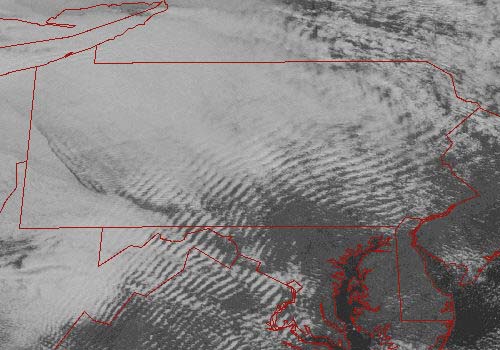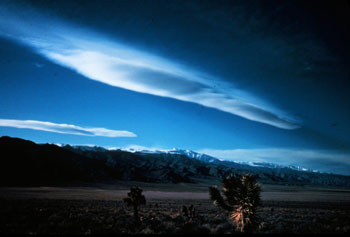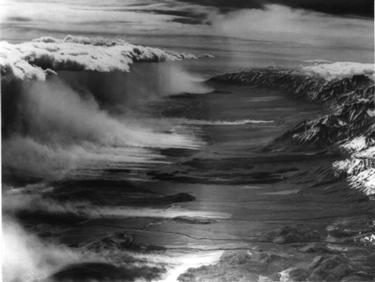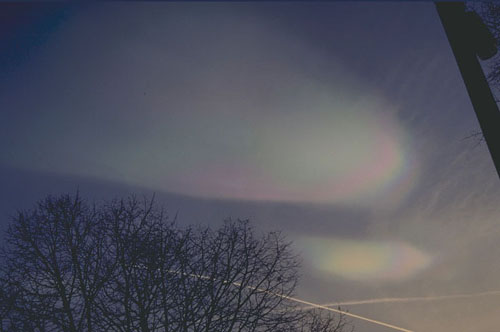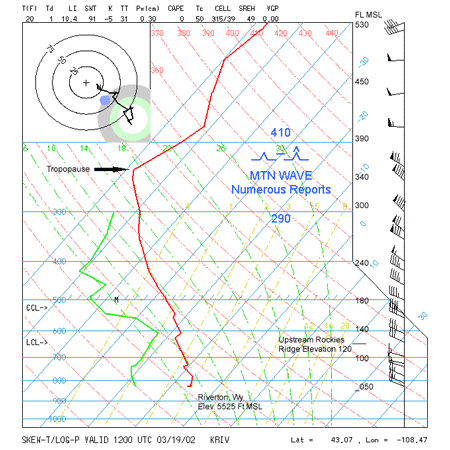 Mountain
Wave
is when a very stable atmosphere transmits the energy from being lifted
up over an obstacle up to the Tropopause.
As the stable air flows across the mountains, it behaves as water
flowing over a rock -- the flow gets a hump, like the bow wave from a
ship moving through water.
Mountain
Wave
is when a very stable atmosphere transmits the energy from being lifted
up over an obstacle up to the Tropopause.
As the stable air flows across the mountains, it behaves as water
flowing over a rock -- the flow gets a hump, like the bow wave from a
ship moving through water.
The prime requirements for Mountain Wave conditions are:
• Very stable atmosphere
• Strong winds flowing across mountain or ridge line
• Wind speeds increasing with altitude
This Skew-T is from the middle of a Mountain Wave event. Numerous turbulence reports were received over Wyoming from FL290 to 410. This layer lies across the 35,000 foot Tropopause.
This example is very stable, because the temperature lapse rate is warmer than (to the right of) the Moist Adiabatic lapse rate throughout the sounding, except for the bit near 750mb. This stability makes the air less "springy" than conditionally stable air.
Usually, this bow shock displacement would dampen out with altitude due to mixing. This leaves you with a normal low-level terrain turbulence type of situation. The stability of the air in this Wyoming event creates a standing wave (like the water hump) which can stack up to the Tropopause and even higher. This standing wave is called a Mountain Wave.
When the Mountain Wave reaches and interacts with the Tropopause inversion, the airflow can be disrupted to the point of extreme vertical motions resembling the turbulent flow of breaking surf. This is where aircraft can encounter Severe and Extreme turbulence due to the Mountain Wave. The up and downdraft vectors can reach over 100 knots within 100 yards! In the example above, note the speed change across the Tropopause above from 90 kt below to 55 kt above the inversion. This combination of shear enhanced by the Mountain Wave made the Tropopause inversion ripple like the surface of a pond, leading to the Severe Turbulence reported by aircraft that day. One aircraft reported losing 5,000 feet when thrown into a 25 degree dive!
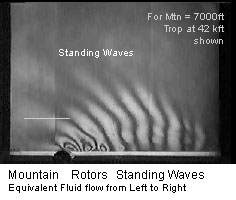 Here
is an atmospheric model showing the left-to-right flow over a
"mountain" creating standing waves in the fluid. This image is turned
upside down for easier viewing.
Here
is an atmospheric model showing the left-to-right flow over a
"mountain" creating standing waves in the fluid. This image is turned
upside down for easier viewing.
Click the Image for an upside-down movie of the Mountain Wave process. This shows a rod (the mountain) moving across the top of a tank of stable, stratified water. The density (Gravity) waves created by the moving "mountain" even include whirling rotors and downstream propagation of the Mountain Waves!
In the movie, the rod moving right-to-left is equivalent of the fluid atmosphere moving left-to-right. This tank model does not have an equivalent Tropopause. If it did, you could see the waves bounce off the Tropopause inversion to create a turbulent region there, too. A white line at left above the model mountain shows a scale Tropopause altitude.
The requirements above include "Strong winds flowing across mountain or ridge line." Keep in mind that the while the perfect case would be winds 90° to the ridge axis, strong winds crossing at a low angle to the ridge axis can still cause mountain wave!
Consider this event:
- Mountain Ridge Axis N-S (360°-180°)
- Wind direction 330°
- Wind Speed 140 Kts
The winds are crossing the ridge axis at a 30° angle. The Sine of 30° is 0.5 or one-half. This means that of the 140 knots moving through the area, the vector wind speed directly crossing the ridge axis is one-half of the total wind speed, or 70 knots! This means, that despite the shallow crossing angle, there is plenty of cross-ridge flow to induce mountain wave. As the crossing angle increases to 90° (perpendicular to the ridge axis), the Sine increases to 1.0. The more perpendicular to the rindge axis, the stronger the wind vector is crossing that axis.
The important thing to remember here is that Strong Winds and Shallow Crossing Angle can create Mountain Wave conditions.
Gravity Waves, also called Buoyancy or Density Waves, are ripples in the atmosphere. They are persistent because the air they move through is stable, so they dampen out through friction, instead of mixing within the layers during less stable conditions.
Because the atmosphere is stable and stratified, there is almost no turbulent mixing from displacement. The bow shock from flow over the mountain is transmitted as density variations in the atmosphere, subject only to gravity (or movement into less stable air) to dampen them out through friction, hence, Gravity Waves. These waves can "bounce" several times downstream of the mountains as well. The space between the mountain ridge and the first downstream bounce is the Foehn Gap seen on Metsat. This is a sure sign of Mountain Wave conditions.
With available moisture, this bouncing can lead to several sets of Venetian Blind lenticular (lens-shaped) clouds downstream of the mountains, such as here.
In the case of Mountain Wave, the stable layer is the depth of the entire Troposphere, enough to transmit the wave force upward into the Stratosphere. Conditions permitting, this energy can travel well into a very stable Stratosphere and even beyond!
|
|
Where there is a thin stable layer, such as with an inversion, Gravity Waves can propagate hundreds of miles downstream as long as the layer remains stable. The inversion acts as a membrane, as in the way the surface of a pond acts to support ripples called Terrain Waves. Further details on this event here. Turbulence with this type of event would be in the shear zone above and below the inversion, throught the depth of the ripples, usually plus/minus 1,000-2,000 ft.
Pushed to extremes, gravity waves can develop into Kelvin-Helmholtz (K-H) Waves which break like surf on the beach, causing extreme turbulence in and near that layer, such as in Low Level Wind Shear.
To sum up:
• Mountain Wave is a type of Gravity Wave which
propagate vertically up to the Tropopause due to
the stable conditions.
• Terrain Waves are also Gravity Waves, but they
propagate horizontally downstream within the stable
layer. Terrain Waves are commonly called Gravity Waves anyway, but just
remember:
- Mountain Wave goes Up!
|
In the late 1960's, this B-52H was researching Mountain Wave Turbulence along the Rocky mountains in southern Colorado. It found some -- Start to finish: less than 10 seconds. The crew and aircraft recovered safely. |
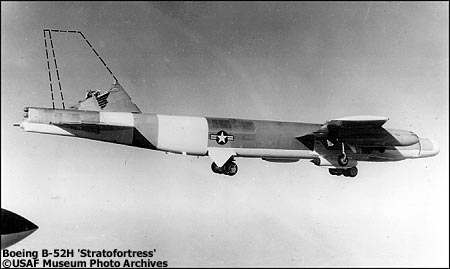 |
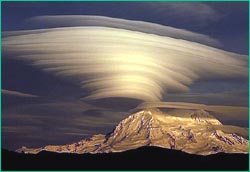 Stacked Plates over Cap Cloud New Mexico Winds Left to Right |
|
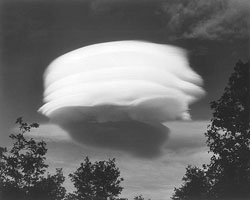 Venetian Blind stack downwind of 14,000 foot Mt. Shasta, California Winds Left to Right |
|
|
Mountain Wave conditions can propagate far into
the Stratosphere, possibly even well into the Mesosphere! This can
affect very high altitude aircraft flights, and are a factor in the
creation of Nacreous (Mother of Pearl) Clouds. |
||
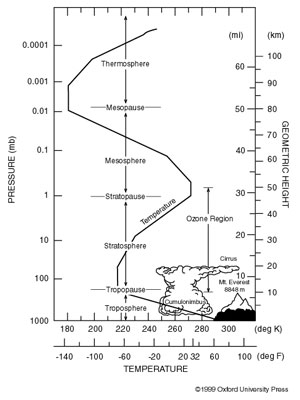 |
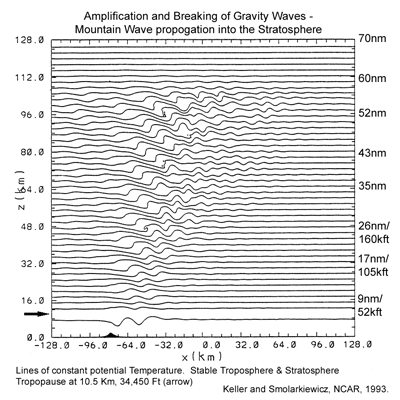 This model shows the potential for Mountain Wave to propagate all the way through the Stratosphere into the Mesosphere! |
|
|
||
Back to Top
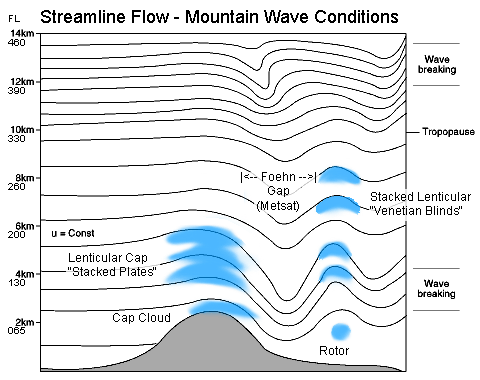 Gravity Waves
Gravity Waves